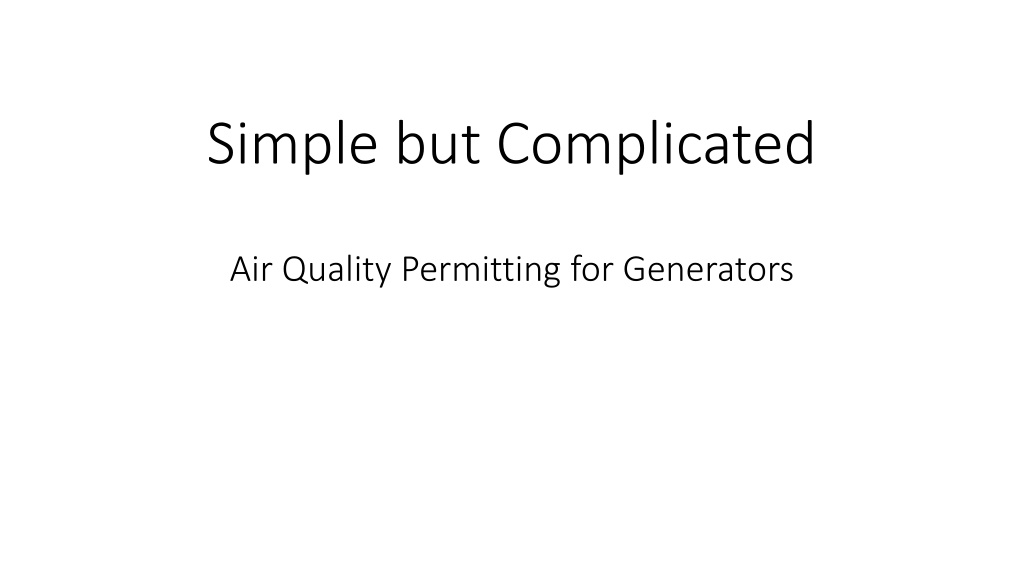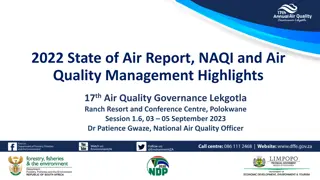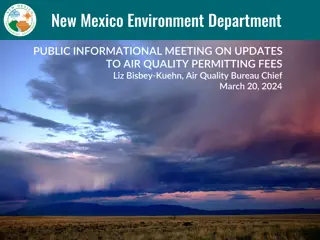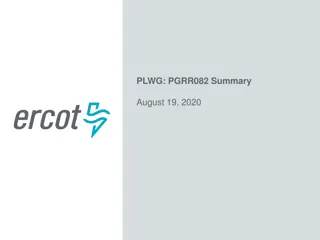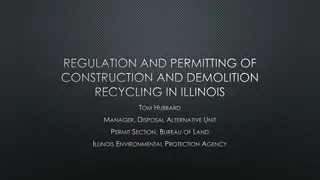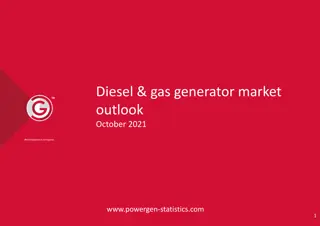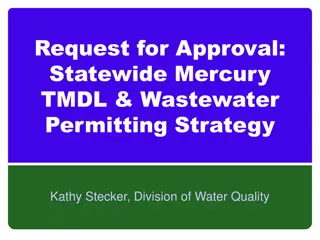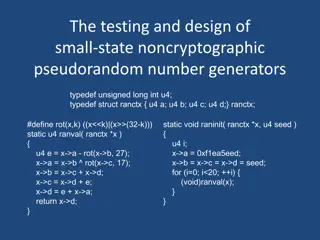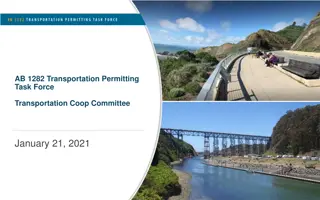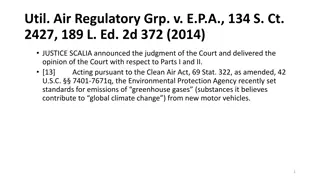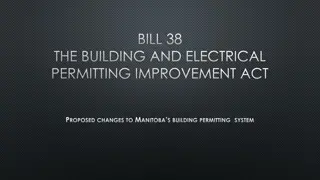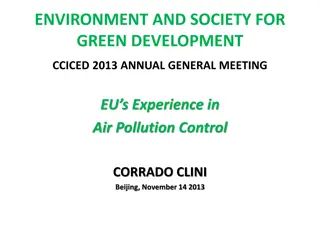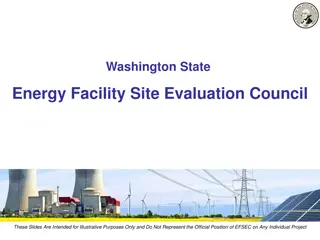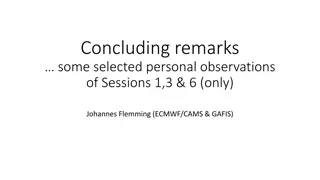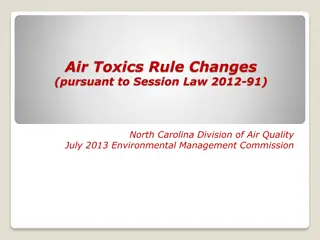Understanding Air Quality Permitting Regulations for Generators
Exploring the complexities of air quality permitting for generators, focusing on regulations in Pinal County for insignificant units and federal rules governing different types of engines. The regulations cover exemption criteria, compliance requirements, and specific guidelines for emergency generators at area sources, along with detailed emission limitations and maintenance practices to ensure environmental compliance.
Download Presentation

Please find below an Image/Link to download the presentation.
The content on the website is provided AS IS for your information and personal use only. It may not be sold, licensed, or shared on other websites without obtaining consent from the author. Download presentation by click this link. If you encounter any issues during the download, it is possible that the publisher has removed the file from their server.
E N D
Presentation Transcript
Simple but Complicated Air Quality Permitting for Generators
Pinal County Generator Rules Pinal County Generator Rules Insignificant Units: Less than 325 HP (243 kW); and Operate less than 72 hours per year. Both the requirements have to be met in order to qualify for an exemption. Insignificant units are not permitted even if subjected to any of the federal standards. More than one insignificant units at a source will be considered as one unit and may need a permit.
Federal Generator Rules Reciprocating Internal Combustion Engine (RICE) National Emission Standard for Hazardous Air Pollutants (NESHAP) RICE NESHAP 40 CFR Part 63 Subpart ZZZZ Generally pre-2006 engines of all fuel types Stationary Compression Ignition (CI) Internal Combustion (IC) Engine New Source Performance Standard (NSPS) Compression Ignition NSPS 40 CFR Part 60 Subpart IIII Generally post-2006 diesel engines Stationary Spark Ignition (SI) Internal Combustion (IC) Engine New Source Performance Standard (NSPS) Spark Ignition NSPS 40 CFR Part 60 Subpart JJJJ Generally post-2006 gas, natural gas and propane engines
NESHAP and Emergency Generators at Area Sources Example: 450 HP compression ignition diesel emergency generator, manufactured 5/1/2005, located at an area source of Hazardous Air Pollutants (HAPs) Area Source of HAPs = single HAP emissions less than 10 ton per year (tpy) and total HAP emissions less than 25 tpy Engine Category = Emergency CI Date Constructed = Before 6/12/06 Compliance Date = all compliance dates are in the past
NESHAP and Emergency Generators Cont. Emission Limitations, Management Practice and Other Requirements = CFR citations lead to Table 2d section labeled Requirements for Existing RICE Located at Area Sources Change oil and filter every 500 hours or annually, whichever comes first Or follow oil analysis procedure Total Base Number is less than 30% of the Total Base Number of the oil when new Viscosity of the oil has changed by more than 20% from new Percent water content (by volume) is greater than 0.5 If you meet all three you do not need to change the oil, if any fail you change the oil within 2 business days or before operation, whichever is later Inspect air cleaner every 1000 hours or annually, whichever comes first, and replace as necessary Inspect all hoses and belts every 500 hours or annually, whichever comes first, and replace as necessary
NESHAP and Emergency Generators Cont. Operating Limitations = No requirements Fuel Requirements = Currently available low sulfur non-road (red dye) diesel Many facilities opt to use the currently available ultra low sulfur on-road diesel (available at gas stations) All the delayed compliance dates have passed Performance Tests = No requirements
NESHAP and Emergency Generators Cont. Monitoring, Installation, Collection, Operation and Maintenance Requirements Follow the manufacturer s maintenance plan and operate the engine in a manner consistent with good air pollution control practices Install a non-resettable hour meter Minimize time spent at idle during startup to less than 30 minutes Initial Compliance = no requirements
NESHAP and Emergency Generators Cont. Continuous Compliance: No operational time limit on the use in emergency situations 100 hours per calendar year limit for: Maintenance checks and readiness testing Emergency demand response (needs to be specifically addressed in your air quality permit) Periods where there is a deviation of voltage or frequency of 5% or greater below standard voltage or frequency 50 hours per calendar year limit for non-emergency use Counts toward the 100 hour limit above Cannot be used for peak shaving or non-emergency demand response or to supply power to the grid (possible under certain conditions)
NESHAP and Emergency Generators Cont. Notification Requirements No (Federal) requirements Check with your local Air Quality permitting agency to see if you need a permit. Recordkeeping Requirements Keep records of: Required maintenance Hours of operation (emergency vs. non-emergency) Reporting Requirements: If greater than 100 HP and operates (or contractually obligated to be available) for more than 15 hours per calendar year for emergency demand response see 40 CFR 63.6650(h) for report requirements (includes electronic reporting to the USEPA) If maintenance is delayed due to the engine running during an emergency (or a few other reasons) report failures to change the oil (or due the analysis) and etc. on time
NESHAP and Emergency Generators Cont. NESHAP requirements are not applicable to the following: Existing residential emergency stationary RICE Homes or apartment buildings Existing commercial emergency stationary RICE Office buildings, hotels, stores, telecommunication facilities, restaurants, financial institutions, doctor s offices, and sports and performing art facilities). Existing institutional emergency stationary Rice Medical centers, nursing homes, research centers, correctional facilities, elementary and secondary schools, libraries, religious establishments, police stations, and fire stations
NESHAP and Non-Emergency Generators at Area Sources If under 300 HP and constructed before 6/12/06 similar to the emergency generator requirements. If over 300 HP and constructed before 6/12/06 Requires performance testing Carbon Monoxide emissions limited Generally requires add on controls (oxidation catalyst, CPMS or CEMS) Generally requires monitoring operational parameters Testing can be avoided by retrofitting the pre-2006 engine with a post 2007 engine Air Quality permit will likely set an annual operational limit.
NSPS and Emergency Generators Example: 450 HP Compression Ignition Emergency Generator, Manufactured 5/1/2015 Engines subject to an NSPS comply with the NESHAP by complying with the NSPS Engine Category = 2007 model year and later emergency CI ICE < 30L/cyl displacement (except fire pump engines) Date Constructed/Reconstructed/Manufactured = Commenced construction after 7/11/05 and manufactured after 4/1/06
NSPS and Emergency Generators Cont. Emission Standards: NMHC + Nox shall not exceed 4.0 g/kW-hr CO shall not exceed 3.5 g/kW-hr PM shall not exceed 0.20 g/kW-hr Exhaust opacity must not exceed 20% during the acceleration mode, 15% during the lugging mode and 50% during peaks in either mode All the above is verified by the manufacturing testing Purchase a compliant engine Emission standards applicability will depend on the generator size, manufacturing year, and displacement.
NSPS and Emergency Generators Cont. Fuel Requirements - Currently available low sulfur non-road (red dye) diesel Use the currently available ultra low sulfur on-road diesel (available at gas stations) All the delayed compliance dates have passed Importing /Installation Requirements most of the delayed dates have passed Does not apply to engines that were removed from one location and reinstalled at a new location
NSPS and Emergency Generators Cont. Monitoring Requirements: Install a non-resettable hour meter If the engine has a diesel particulate filter to comply with the applicable emission standard install a backpressure monitor that alarms when the backpressure limit is approached Compliance Requirements: Operate and maintain the engine to achieve the emission standards over the entire life of the engine Operate and maintain the engine (and control device) according to the manufacturer s instructions Purchase a certified engine
NSPS and Emergency Generators Cont. Compliance Requirements (continued): No operational limit in emergency situations 100 hours per calendar year limit for: Maintenance checks and readiness testing Emergency demand response (needs to be specifically addressed in your air quality permit) Periods where there is a deviation of voltage or frequency of 5% or greater below standard voltage or frequency 50 hours per calendar year limit for non-emergency use Counts toward the 100 hour limit above Cannot be used for peak shaving or non-emergency demand response or to supply power to the grid (possible under certain conditions)
NSPS and Emergency Generators Cont. Compliance Requirements (continued): Failure to follow the manufacturer s instructions will result in: Developing a maintenance plan and Conducting performance testing (reoccurring if over 500 HP) Testing Requirements: No requirements Violation of any applicable standard requires testing per 40 CFR 60.4212
NSPS and Emergency Generators Cont. Notification, Reports, and Records Requirements: No Federal initial notification required Check with your local Air Quality permitting agency to see if you need a permit. If equipped with a particulate matter filter keep records of corrective actions in response to the backpressure monitor alarms If greater than 100 HP and operates (or contractually obligated to be available) for more than 15 hours per calendar year for emergency demand response see 40 CFR 60.4214(d) for report requirements (includes electronic reporting to the USEPA)
NSPS and Non-Emergency Generators Example: 450 HP Compression Ignition (or CI or diesel) Non- Emergency Generator, Manufactured 5/1/2015 Engines subject to an NSPS comply with the NESHAP by complying with the NSPS NSPS Subpart IIII = Diesel
NSPS and Non-Emergency Generators Cont. Similar to Emergency Generators with the following exceptions Emission Standards must comply with the current Tier based on the year of manufacture i.e., Tier 4 after 2014 model year The emergency hourly limits do not apply Air Quality permit will likely set an annual operational limit Generally non-emergency engines located at a facility for more than one year will need an air quality permit. Replacements do not reset the clock
Contact Information Anu Jain Pinal County Air Quality 520-866-6931 anu.Jain@pinalcountyaz.gov
